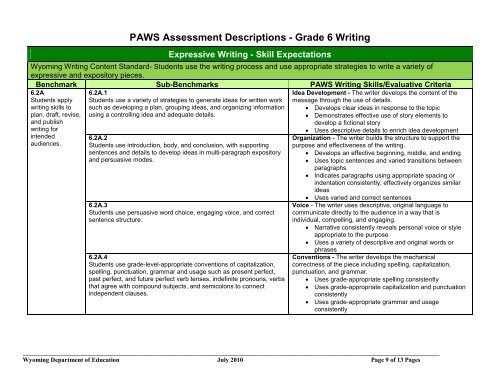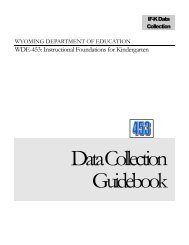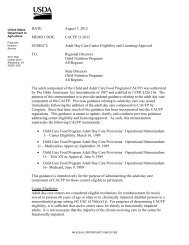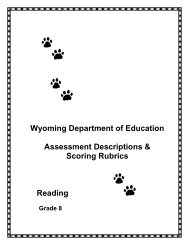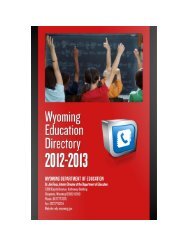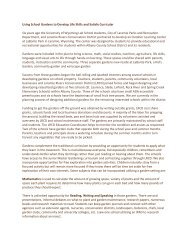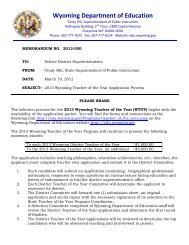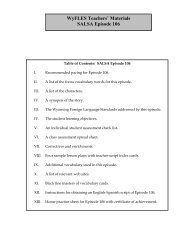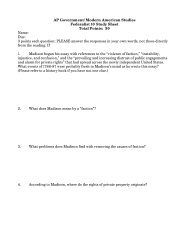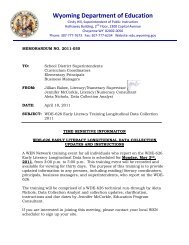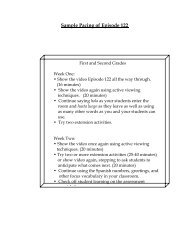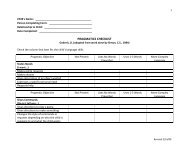Writing Assessment Descriptions-Writing Scoring Guide Grade 6
Writing Assessment Descriptions-Writing Scoring Guide Grade 6
Writing Assessment Descriptions-Writing Scoring Guide Grade 6
You also want an ePaper? Increase the reach of your titles
YUMPU automatically turns print PDFs into web optimized ePapers that Google loves.
PAWS <strong>Assessment</strong> <strong>Descriptions</strong> - <strong>Grade</strong> 6 <strong>Writing</strong><br />
Expressive <strong>Writing</strong> - Skill Expectations<br />
Wyoming <strong>Writing</strong> Content Standard- Students use the writing process and use appropriate strategies to write a variety of<br />
expressive and expository pieces.<br />
Benchmark Sub-Benchmarks PAWS <strong>Writing</strong> Skills/Evaluative Criteria<br />
6.2A<br />
Students apply<br />
writing skills to<br />
plan, draft, revise,<br />
and publish<br />
writing for<br />
intended<br />
audiences.<br />
6.2A.1<br />
Students use a variety of strategies to generate ideas for written work<br />
such as developing a plan, grouping ideas, and organizing information<br />
using a controlling idea and adequate details.<br />
6.2A.2<br />
Students use introduction, body, and conclusion, with supporting<br />
sentences and details to develop ideas in multi-paragraph expository<br />
and persuasive modes.<br />
6.2A.3<br />
Students use persuasive word choice, engaging voice, and correct<br />
sentence structure.<br />
6.2A.4<br />
Students use grade-level-appropriate conventions of capitalization,<br />
spelling, punctuation, grammar and usage such as present perfect,<br />
past perfect, and future perfect verb tenses, indefinite pronouns, verbs<br />
that agree with compound subjects, and semicolons to connect<br />
independent clauses.<br />
Idea Development - The writer develops the content of the<br />
message through the use of details.<br />
• Develops clear ideas in response to the topic<br />
• Demonstrates effective use of story elements to<br />
develop a fictional story<br />
• Uses descriptive details to enrich idea development<br />
Organization - The writer builds the structure to support the<br />
purpose and effectiveness of the writing.<br />
• Develops an effective beginning, middle, and ending<br />
• Uses topic sentences and varied transitions between<br />
paragraphs<br />
• Indicates paragraphs using appropriate spacing or<br />
indentation consistently; effectively organizes similar<br />
ideas<br />
• Uses varied and correct sentences<br />
Voice - The writer uses descriptive, original language to<br />
communicate directly to the audience in a way that is<br />
individual, compelling, and engaging.<br />
• Narrative consistently reveals personal voice or style<br />
appropriate to the purpose<br />
• Uses a variety of descriptive and original words or<br />
phrases<br />
Conventions - The writer develops the mechanical<br />
correctness of the piece including spelling, capitalization,<br />
punctuation, and grammar.<br />
• Uses grade-appropriate spelling consistently<br />
• Uses grade-appropriate capitalization and punctuation<br />
consistently<br />
• Uses grade-appropriate grammar and usage<br />
consistently<br />
____________________________________________________________________________________________________________________________________<br />
Wyoming Department of Education July 2010 Page 9 of 13 Pages


